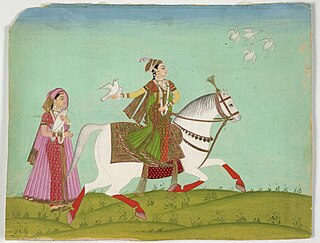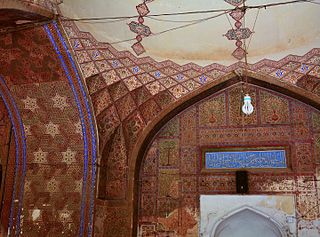
Muslim period in the Indian subcontinent (712–1757) is conventionally said to have started in 712, after the conquest of Sindh and Multan by the Umayyad Caliphate. It began in the Indian subcontinent in the course of a gradual conquest. The perfunctory rule by the Ghaznavids in Punjab was followed by Ghurids, and Sultan Muhammad of Ghor is generally credited with laying the foundation of Muslim rule in Northern India.
Banu, also spelled Bano, is a Persian name for girls popular in Iran and other Persian-speaking countries. It is also used in Turkey, Pakistan Bangladesh, Azerbaijan, India and Sri Lanka. It means "grand lady", "princess" or "queen" in Persian.

The Yusufzai or Yousafzai, also referred to as the Esapzai, or Yusufzai Afghans historically, are one of the largest tribes of ethnic Pashtuns. They are natively based in the northern part of Khyber Pakhtunkhwa, to which they migrated from Kabul during the 16th century, but they are also present in smaller numbers in parts of Afghanistan, including Kunar, Kabul, Kandahar and Farah. Outside of these countries, they can be found in Ghoriwala District Bannu, Balochistan Sibi (Akazai), Chagai (Hassanzai) and Rohilkandh.

Pardah or purdah is a religious and social practice of female seclusion prevalent among some Muslim and Hindu communities. It takes two forms: physical segregation of the sexes and the requirement that women cover their bodies so as to cover their skin and conceal their form. A woman who practices purdah can be referred to as pardanashin or purdahnishan. The term purdah is sometimes applied to similar practices in other parts of the world.

Mughal architecture is the type of Indo-Islamic architecture developed by the Mughals in the 16th, 17th and 18th centuries throughout the ever-changing extent of their empire in the Indian subcontinent. It developed from the architectural styles of earlier Muslim dynasties in India and from Iranian and Central Asian architectural traditions, particularly Timurid architecture. It also further incorporated and syncretized influences from wider Indian architecture, especially during the reign of Akbar. Mughal buildings have a uniform pattern of structure and character, including large bulbous domes, slender minarets at the corners, massive halls, large vaulted gateways, and delicate ornamentation; examples of the style can be found in modern-day Afghanistan, Bangladesh, India and Pakistan.

The Lodi dynasty was a dynasty that ruled the Delhi Sultanate from 1451 to 1526. It was the fifth and final dynasty of the Delhi Sultanate, and was founded by Bahlul Khan Lodi when he replaced the Sayyid dynasty.
Mirza is a name of Persian origin. It is used as a surname or prefix to identify patriarchal lineage.

Ibrahim Adil Shah II was king of the Sultanate of Bijapur and a member of the Adil Shahi dynasty. Under his reign the dynasty had its greatest period as he extended its frontier as far south as Mysore. He was a skilful administrator, artist, poet and a generous patron of the arts. He reverted to the Sunni orthodoxy of Islam, but remained tolerant of other religions, including Christianity. However, during his reign high-ranking Shiite immigrants became unwelcome and in 1590, he ordered the confinement of criers who read the khutba in the Shia form. After his reign, increasing weakness permitted Mughal encroachment and the successful revolt of the Maratha king Shivaji, who killed the Bijapur general Afzal Khan and scattered his army. The dynasty left a tradition of cosmopolitan culture and artistic patronage whose architectural remains are to be seen in the capital city of Bijapur.

Mariam-uz-Zamani ;, commonly known by the misnomer Jodha Bai, was the chief consort and principal Hindu wife as well as the favourite wife of the third Mughal emperor, Akbar. She was also the longest-serving Hindu empress of the Mughal Empire with a tenure of forty-three years (1562–1605).
Bibi is a given name, nickname and surname.

Indo-Islamic architecture is the architecture of the Indian subcontinent produced by and for Islamic patrons and purposes. Despite an initial Arab presence in Sindh, the development of Indo-Islamic architecture began in earnest with the establishment of Delhi as the capital of the Ghurid dynasty in 1193. Succeeding the Ghurids was the Delhi Sultanate, a series of Central Asian dynasties that consolidated much of North India, and later the Mughal Empire by the 15th century. Both of these dynasties introduced Islamic architecture and art styles from West Asia into the Indian subcontinent.
Khan is a surname of Afghan-Mongol origin, today most commonly found in parts of India, Pakistan, Afghanistan, Bangladesh, and Iran. It is derived from the historic title khan, referring to military chief or royalty. It originated as a hereditary title among nomadic tribes in the Central and Eastern Eurasian Steppe during antiquity and was popularized by Afghan dynasties in the rest of Asia as well as in Eastern Europe during the medieval period.
Bibi Mubarika Yusufzai was the Empress consort of the Mughal Empire. She was the fifth wife of Emperor Babur, the founder of the Mughal Empire and the first Mughal emperor.

Sultana Chand Bibi was an Indian ruler and warrior. She acted as the Regent of Bijapur Sultanate during the minority of Ibrahim Adil Shah II in 1580-1590, and regent of Ahmednagar Sultanate during the minority of her great nephew Bahadur Shah in 1595-1600. Chand Bibi is best known for defending Ahmednagar against the Mughal forces of Emperor Akbar in 1595.

Begum Shahi Mosque, officially The Mosque ofMariyam Zamani Begum, is an early 17th-century mosque situated in the Walled City of Lahore, Punjab, Pakistan. Constructed by Mughal Empress Mariam-uz-Zamani, chief consort of Emperor Akbar, it is one of the largest mosques in Pakistan. The mosque was built between 1611 and 1614 during the reign of Mughal Emperor Jahangir.
Begum is a female title which is also used in Mirza families/lineages, Daughter of Beg or Wife of Beg, a given name and surname.
Badshah Begum was Empress consort of the Mughal Empire from 8 December 1721 to 6 April 1748 as the first wife and chief consort of the Mughal emperor Muhammad Shah. She is popularly known by her title Malika-uz-Zamani which was conferred upon her by her husband, immediately after their marriage.
Bega Begum was Empress consort of the Mughal Empire from 26 December 1530 to 17 May 1540 and 22 February 1555 to 27 January 1556 as the first wife and chief consort of the second Mughal emperor Humayun. She was known as Zan-i-Kalan being the first wife of Humayun and was also known as Haji Begum after she performed the Hajj pilgrimage.
The study of women's history in the Indian subcontinent has been a major scholarly and popular field, with many scholarly books and articles, museum exhibits, and courses in schools and universities.










